Statistical Hypothesis Testing: F-test, T-test & Chi-Square Analysis
VerifiedAdded on 2023/04/23
|8
|1470
|148
Homework Assignment
AI Summary
This assignment provides detailed solutions to various statistical problems, demonstrating the application of F-tests, paired T-tests, independent T-tests, and Chi-square tests. The problems cover a range of scenarios, including comparing variances between research studies, examining differences in means between groups, testing for relationships between categorical variables, and assessing the effectiveness of treatments. Each solution includes the formulation of null and alternative hypotheses, the selection of the appropriate statistical test, and the interpretation of results based on computed test statistics and critical values. Specific examples include analyzing differences in variances, comparing depression scores between drug addicts and non-addicts, evaluating the effectiveness of relaxation training, and investigating the relationship between attractiveness and anxiety scores.

21.4
F-test
The problem in this case is to determine the difference between the results of the previous
research design and the current study through determining whether the variances of the research
from the 2 researches are statistically different. As such, an F-test is used which examines the
difference in variances. In examining the difference in variance, the following formulae is used:
Fcritical ¿ Variance1
Variance2
To address the reaserch problem the following hypothesis can be formulated:
Ho: There is a difference in variances
Ha: There is no difference in variances.
Where the researcher should reject the null hypothesis if the tabular F-statistic is less than the
computed. If the null is rejected, then there are differences in the results of the two researches.
21.7
F-test
The data for this scenario is quantitative i.e. age. As such, to examine whether there is a
difference in the month of birth for creative artists an F-test for difference for comparison of
variances is adopted. Hence the hypothesis to be formulated is:
Ho: There is a difference in variances
Ha: There is no difference in variances.
The F-statistic is then given by:
F-test
The problem in this case is to determine the difference between the results of the previous
research design and the current study through determining whether the variances of the research
from the 2 researches are statistically different. As such, an F-test is used which examines the
difference in variances. In examining the difference in variance, the following formulae is used:
Fcritical ¿ Variance1
Variance2
To address the reaserch problem the following hypothesis can be formulated:
Ho: There is a difference in variances
Ha: There is no difference in variances.
Where the researcher should reject the null hypothesis if the tabular F-statistic is less than the
computed. If the null is rejected, then there are differences in the results of the two researches.
21.7
F-test
The data for this scenario is quantitative i.e. age. As such, to examine whether there is a
difference in the month of birth for creative artists an F-test for difference for comparison of
variances is adopted. Hence the hypothesis to be formulated is:
Ho: There is a difference in variances
Ha: There is no difference in variances.
The F-statistic is then given by:
Paraphrase This Document
Need a fresh take? Get an instant paraphrase of this document with our AI Paraphraser
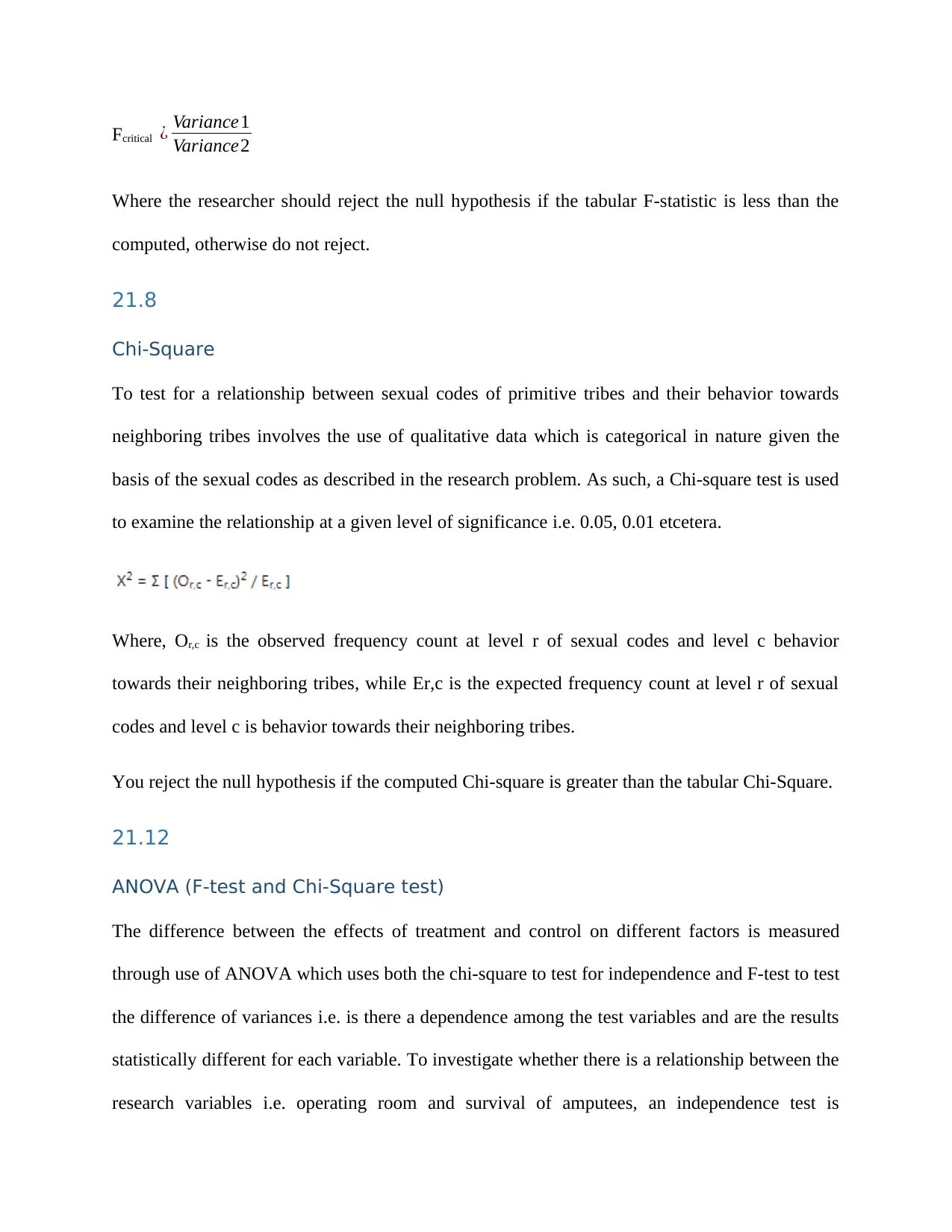
Fcritical ¿ Variance1
Variance2
Where the researcher should reject the null hypothesis if the tabular F-statistic is less than the
computed, otherwise do not reject.
21.8
Chi-Square
To test for a relationship between sexual codes of primitive tribes and their behavior towards
neighboring tribes involves the use of qualitative data which is categorical in nature given the
basis of the sexual codes as described in the research problem. As such, a Chi-square test is used
to examine the relationship at a given level of significance i.e. 0.05, 0.01 etcetera.
Where, Or,c is the observed frequency count at level r of sexual codes and level c behavior
towards their neighboring tribes, while Er,c is the expected frequency count at level r of sexual
codes and level c is behavior towards their neighboring tribes.
You reject the null hypothesis if the computed Chi-square is greater than the tabular Chi-Square.
21.12
ANOVA (F-test and Chi-Square test)
The difference between the effects of treatment and control on different factors is measured
through use of ANOVA which uses both the chi-square to test for independence and F-test to test
the difference of variances i.e. is there a dependence among the test variables and are the results
statistically different for each variable. To investigate whether there is a relationship between the
research variables i.e. operating room and survival of amputees, an independence test is
Variance2
Where the researcher should reject the null hypothesis if the tabular F-statistic is less than the
computed, otherwise do not reject.
21.8
Chi-Square
To test for a relationship between sexual codes of primitive tribes and their behavior towards
neighboring tribes involves the use of qualitative data which is categorical in nature given the
basis of the sexual codes as described in the research problem. As such, a Chi-square test is used
to examine the relationship at a given level of significance i.e. 0.05, 0.01 etcetera.
Where, Or,c is the observed frequency count at level r of sexual codes and level c behavior
towards their neighboring tribes, while Er,c is the expected frequency count at level r of sexual
codes and level c is behavior towards their neighboring tribes.
You reject the null hypothesis if the computed Chi-square is greater than the tabular Chi-Square.
21.12
ANOVA (F-test and Chi-Square test)
The difference between the effects of treatment and control on different factors is measured
through use of ANOVA which uses both the chi-square to test for independence and F-test to test
the difference of variances i.e. is there a dependence among the test variables and are the results
statistically different for each variable. To investigate whether there is a relationship between the
research variables i.e. operating room and survival of amputees, an independence test is
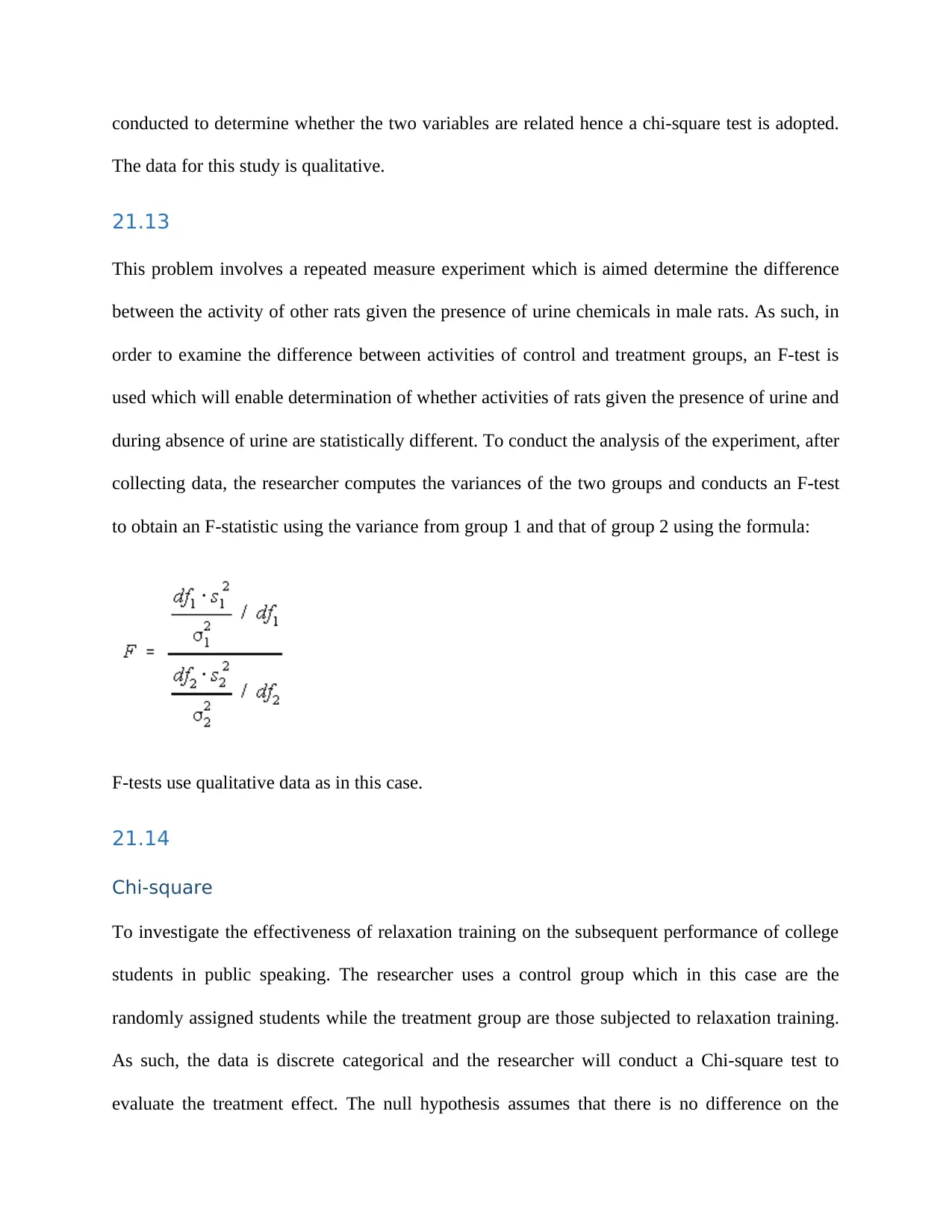
conducted to determine whether the two variables are related hence a chi-square test is adopted.
The data for this study is qualitative.
21.13
This problem involves a repeated measure experiment which is aimed determine the difference
between the activity of other rats given the presence of urine chemicals in male rats. As such, in
order to examine the difference between activities of control and treatment groups, an F-test is
used which will enable determination of whether activities of rats given the presence of urine and
during absence of urine are statistically different. To conduct the analysis of the experiment, after
collecting data, the researcher computes the variances of the two groups and conducts an F-test
to obtain an F-statistic using the variance from group 1 and that of group 2 using the formula:
F-tests use qualitative data as in this case.
21.14
Chi-square
To investigate the effectiveness of relaxation training on the subsequent performance of college
students in public speaking. The researcher uses a control group which in this case are the
randomly assigned students while the treatment group are those subjected to relaxation training.
As such, the data is discrete categorical and the researcher will conduct a Chi-square test to
evaluate the treatment effect. The null hypothesis assumes that there is no difference on the
The data for this study is qualitative.
21.13
This problem involves a repeated measure experiment which is aimed determine the difference
between the activity of other rats given the presence of urine chemicals in male rats. As such, in
order to examine the difference between activities of control and treatment groups, an F-test is
used which will enable determination of whether activities of rats given the presence of urine and
during absence of urine are statistically different. To conduct the analysis of the experiment, after
collecting data, the researcher computes the variances of the two groups and conducts an F-test
to obtain an F-statistic using the variance from group 1 and that of group 2 using the formula:
F-tests use qualitative data as in this case.
21.14
Chi-square
To investigate the effectiveness of relaxation training on the subsequent performance of college
students in public speaking. The researcher uses a control group which in this case are the
randomly assigned students while the treatment group are those subjected to relaxation training.
As such, the data is discrete categorical and the researcher will conduct a Chi-square test to
evaluate the treatment effect. The null hypothesis assumes that there is no difference on the
⊘ This is a preview!⊘
Do you want full access?
Subscribe today to unlock all pages.

Trusted by 1+ million students worldwide
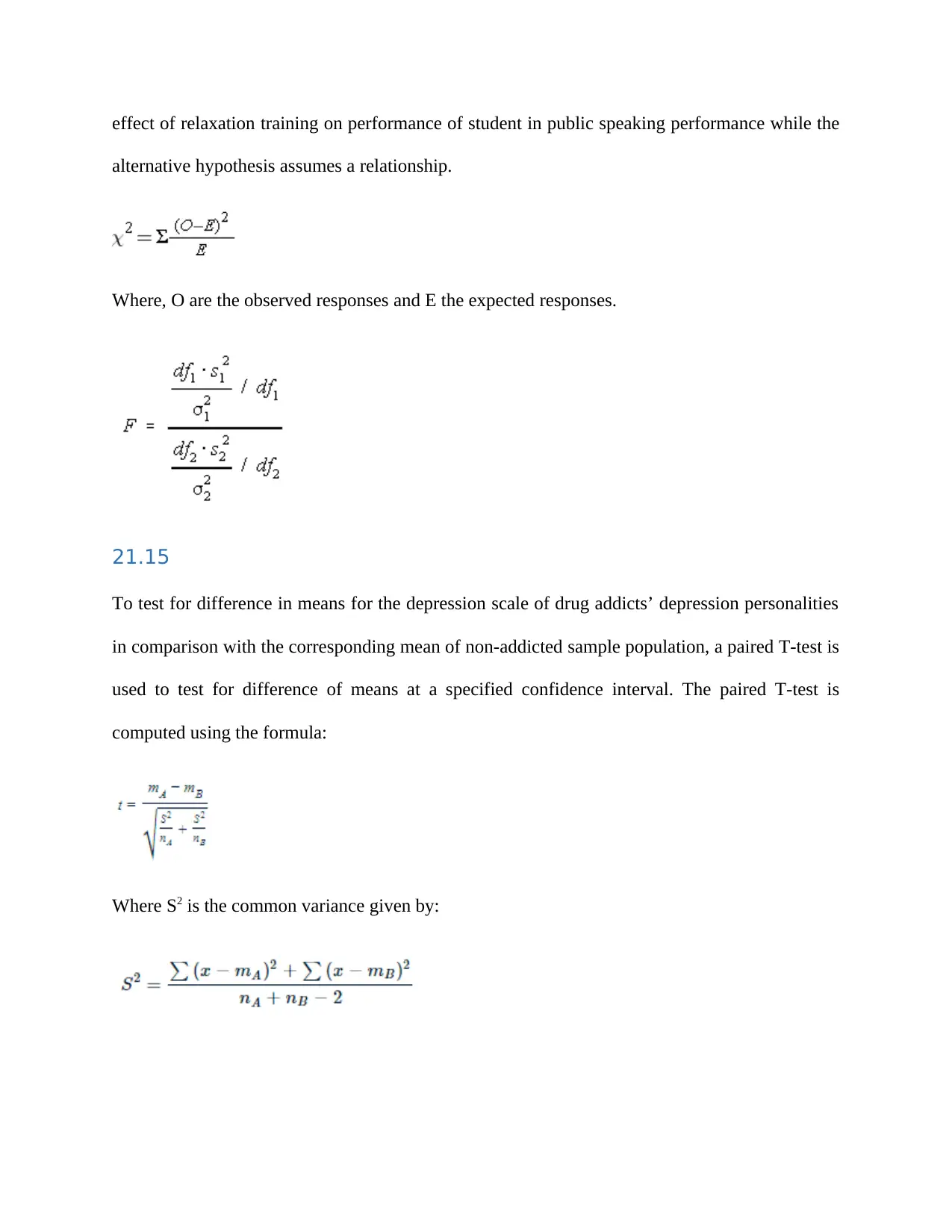
effect of relaxation training on performance of student in public speaking performance while the
alternative hypothesis assumes a relationship.
Where, O are the observed responses and E the expected responses.
21.15
To test for difference in means for the depression scale of drug addicts’ depression personalities
in comparison with the corresponding mean of non-addicted sample population, a paired T-test is
used to test for difference of means at a specified confidence interval. The paired T-test is
computed using the formula:
Where S2 is the common variance given by:
alternative hypothesis assumes a relationship.
Where, O are the observed responses and E the expected responses.
21.15
To test for difference in means for the depression scale of drug addicts’ depression personalities
in comparison with the corresponding mean of non-addicted sample population, a paired T-test is
used to test for difference of means at a specified confidence interval. The paired T-test is
computed using the formula:
Where S2 is the common variance given by:
Paraphrase This Document
Need a fresh take? Get an instant paraphrase of this document with our AI Paraphraser
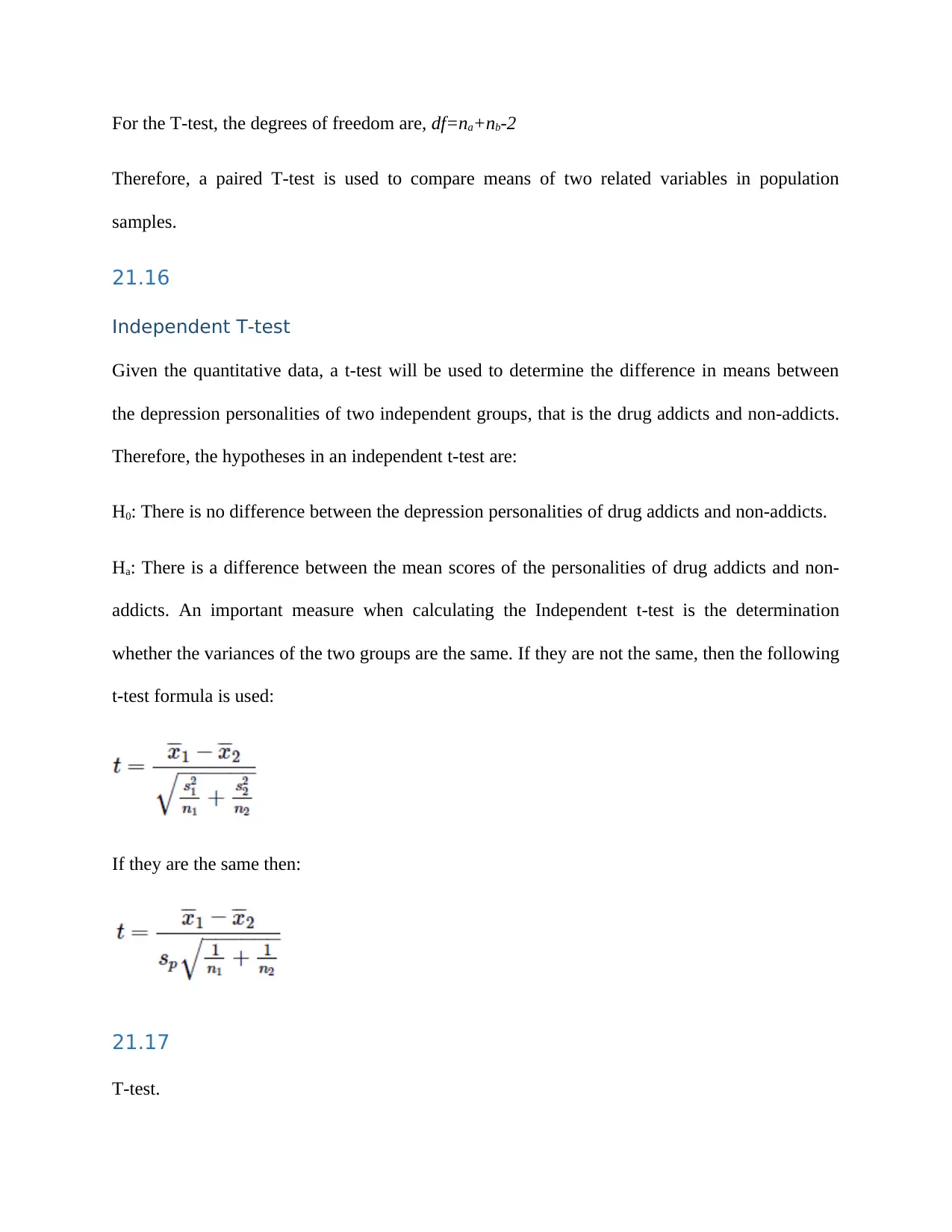
For the T-test, the degrees of freedom are, df=na+nb-2
Therefore, a paired T-test is used to compare means of two related variables in population
samples.
21.16
Independent T-test
Given the quantitative data, a t-test will be used to determine the difference in means between
the depression personalities of two independent groups, that is the drug addicts and non-addicts.
Therefore, the hypotheses in an independent t-test are:
H0: There is no difference between the depression personalities of drug addicts and non-addicts.
Ha: There is a difference between the mean scores of the personalities of drug addicts and non-
addicts. An important measure when calculating the Independent t-test is the determination
whether the variances of the two groups are the same. If they are not the same, then the following
t-test formula is used:
If they are the same then:
21.17
T-test.
Therefore, a paired T-test is used to compare means of two related variables in population
samples.
21.16
Independent T-test
Given the quantitative data, a t-test will be used to determine the difference in means between
the depression personalities of two independent groups, that is the drug addicts and non-addicts.
Therefore, the hypotheses in an independent t-test are:
H0: There is no difference between the depression personalities of drug addicts and non-addicts.
Ha: There is a difference between the mean scores of the personalities of drug addicts and non-
addicts. An important measure when calculating the Independent t-test is the determination
whether the variances of the two groups are the same. If they are not the same, then the following
t-test formula is used:
If they are the same then:
21.17
T-test.
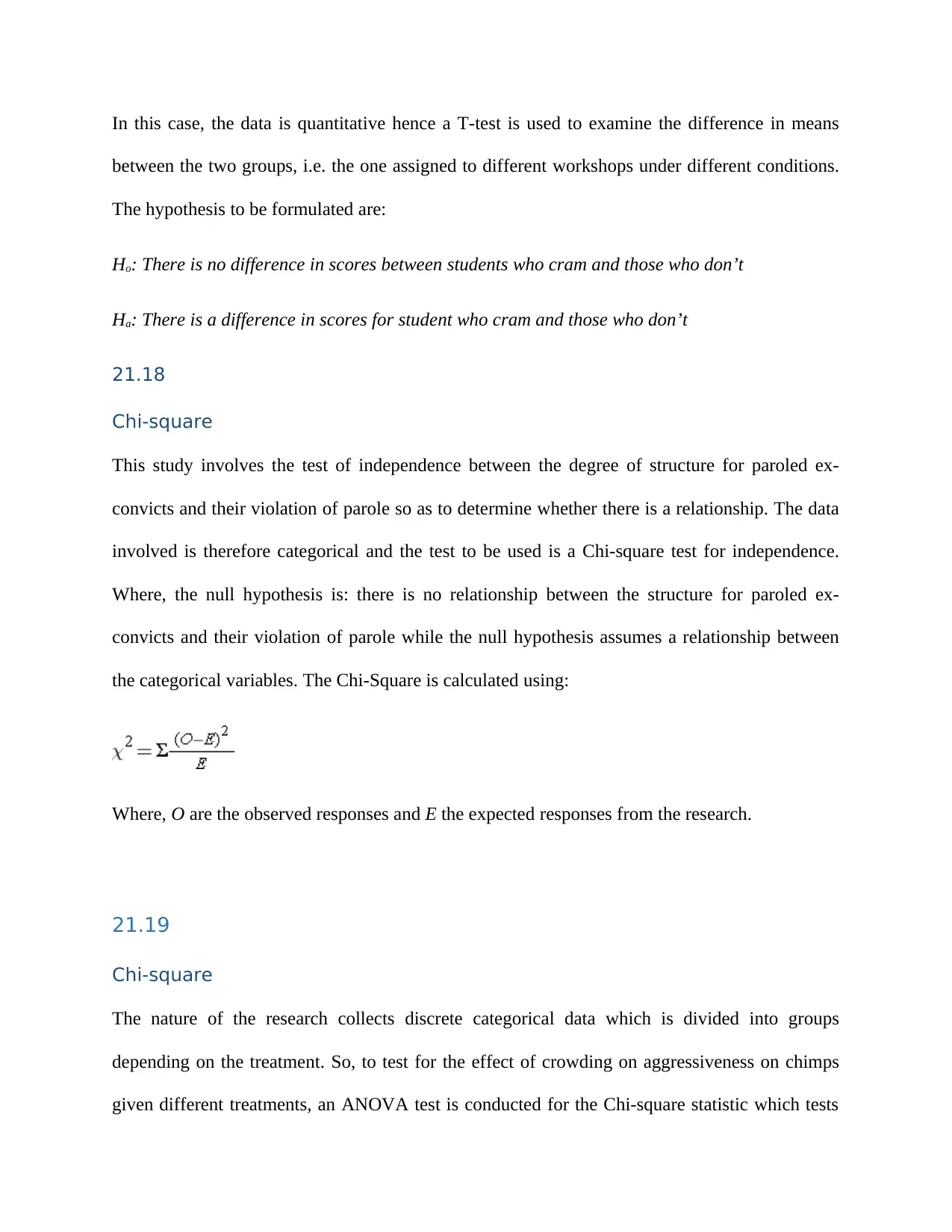
In this case, the data is quantitative hence a T-test is used to examine the difference in means
between the two groups, i.e. the one assigned to different workshops under different conditions.
The hypothesis to be formulated are:
Ho: There is no difference in scores between students who cram and those who don’t
Ha: There is a difference in scores for student who cram and those who don’t
21.18
Chi-square
This study involves the test of independence between the degree of structure for paroled ex-
convicts and their violation of parole so as to determine whether there is a relationship. The data
involved is therefore categorical and the test to be used is a Chi-square test for independence.
Where, the null hypothesis is: there is no relationship between the structure for paroled ex-
convicts and their violation of parole while the null hypothesis assumes a relationship between
the categorical variables. The Chi-Square is calculated using:
Where, O are the observed responses and E the expected responses from the research.
21.19
Chi-square
The nature of the research collects discrete categorical data which is divided into groups
depending on the treatment. So, to test for the effect of crowding on aggressiveness on chimps
given different treatments, an ANOVA test is conducted for the Chi-square statistic which tests
between the two groups, i.e. the one assigned to different workshops under different conditions.
The hypothesis to be formulated are:
Ho: There is no difference in scores between students who cram and those who don’t
Ha: There is a difference in scores for student who cram and those who don’t
21.18
Chi-square
This study involves the test of independence between the degree of structure for paroled ex-
convicts and their violation of parole so as to determine whether there is a relationship. The data
involved is therefore categorical and the test to be used is a Chi-square test for independence.
Where, the null hypothesis is: there is no relationship between the structure for paroled ex-
convicts and their violation of parole while the null hypothesis assumes a relationship between
the categorical variables. The Chi-Square is calculated using:
Where, O are the observed responses and E the expected responses from the research.
21.19
Chi-square
The nature of the research collects discrete categorical data which is divided into groups
depending on the treatment. So, to test for the effect of crowding on aggressiveness on chimps
given different treatments, an ANOVA test is conducted for the Chi-square statistic which tests
⊘ This is a preview!⊘
Do you want full access?
Subscribe today to unlock all pages.

Trusted by 1+ million students worldwide
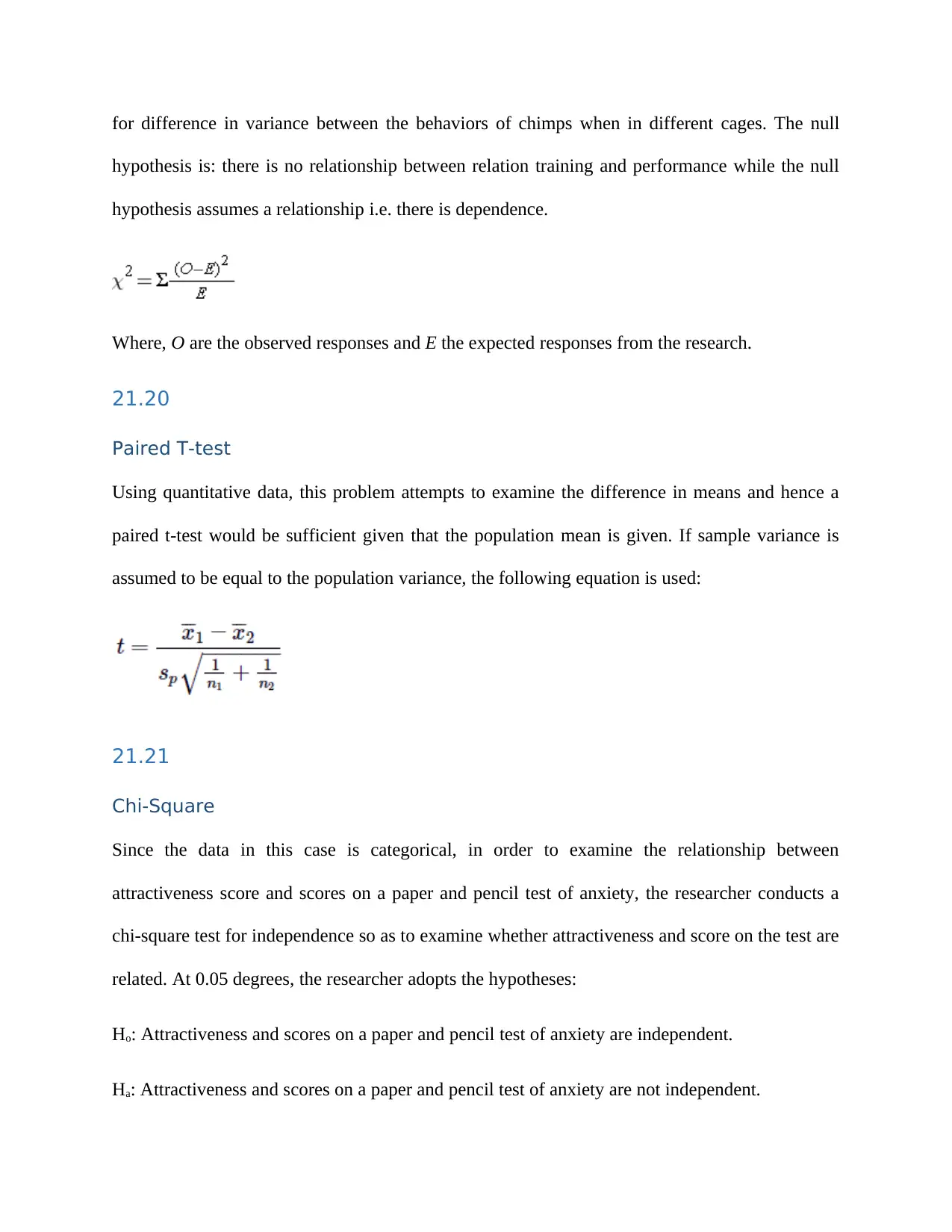
for difference in variance between the behaviors of chimps when in different cages. The null
hypothesis is: there is no relationship between relation training and performance while the null
hypothesis assumes a relationship i.e. there is dependence.
Where, O are the observed responses and E the expected responses from the research.
21.20
Paired T-test
Using quantitative data, this problem attempts to examine the difference in means and hence a
paired t-test would be sufficient given that the population mean is given. If sample variance is
assumed to be equal to the population variance, the following equation is used:
21.21
Chi-Square
Since the data in this case is categorical, in order to examine the relationship between
attractiveness score and scores on a paper and pencil test of anxiety, the researcher conducts a
chi-square test for independence so as to examine whether attractiveness and score on the test are
related. At 0.05 degrees, the researcher adopts the hypotheses:
Ho: Attractiveness and scores on a paper and pencil test of anxiety are independent.
Ha: Attractiveness and scores on a paper and pencil test of anxiety are not independent.
hypothesis is: there is no relationship between relation training and performance while the null
hypothesis assumes a relationship i.e. there is dependence.
Where, O are the observed responses and E the expected responses from the research.
21.20
Paired T-test
Using quantitative data, this problem attempts to examine the difference in means and hence a
paired t-test would be sufficient given that the population mean is given. If sample variance is
assumed to be equal to the population variance, the following equation is used:
21.21
Chi-Square
Since the data in this case is categorical, in order to examine the relationship between
attractiveness score and scores on a paper and pencil test of anxiety, the researcher conducts a
chi-square test for independence so as to examine whether attractiveness and score on the test are
related. At 0.05 degrees, the researcher adopts the hypotheses:
Ho: Attractiveness and scores on a paper and pencil test of anxiety are independent.
Ha: Attractiveness and scores on a paper and pencil test of anxiety are not independent.
Paraphrase This Document
Need a fresh take? Get an instant paraphrase of this document with our AI Paraphraser
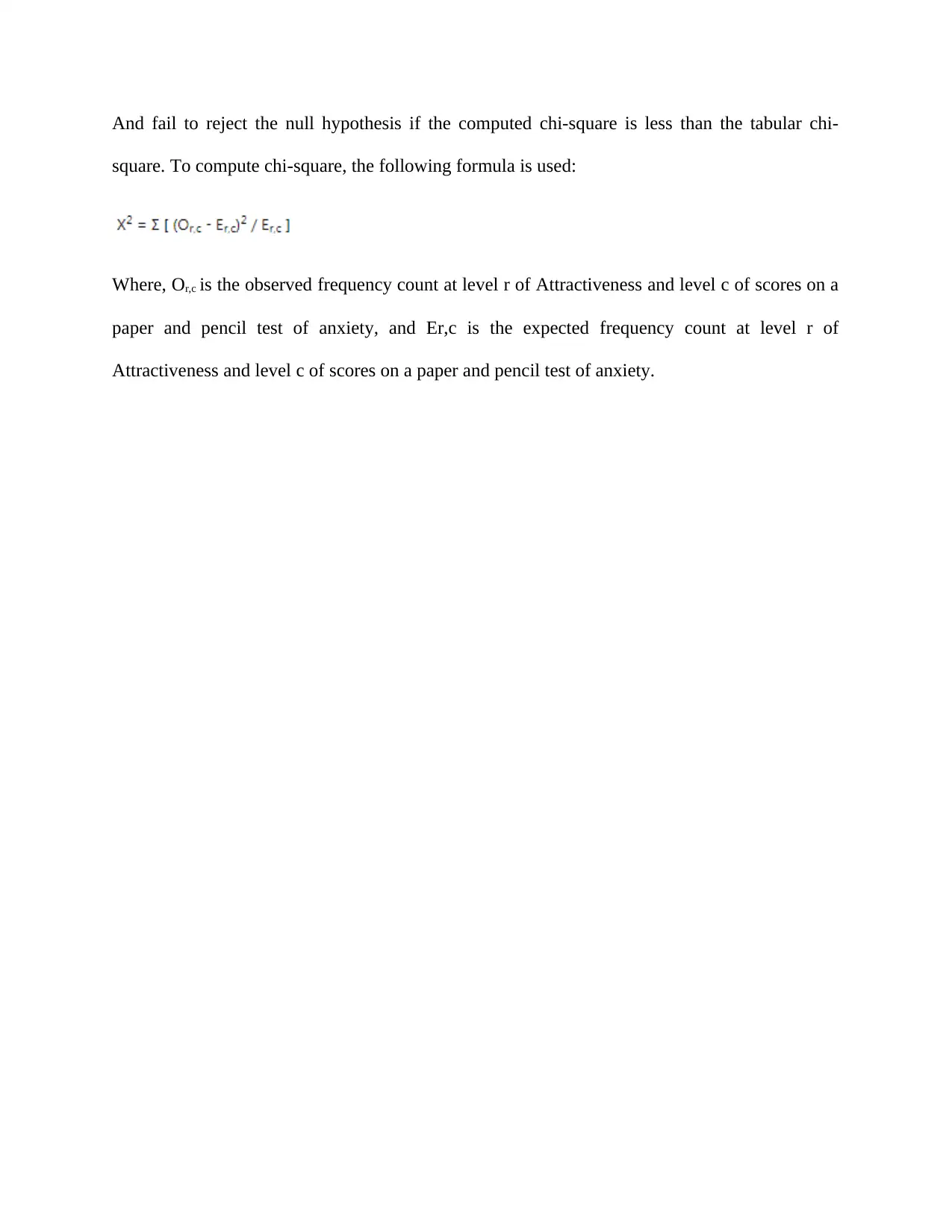
And fail to reject the null hypothesis if the computed chi-square is less than the tabular chi-
square. To compute chi-square, the following formula is used:
Where, Or,c is the observed frequency count at level r of Attractiveness and level c of scores on a
paper and pencil test of anxiety, and Er,c is the expected frequency count at level r of
Attractiveness and level c of scores on a paper and pencil test of anxiety.
square. To compute chi-square, the following formula is used:
Where, Or,c is the observed frequency count at level r of Attractiveness and level c of scores on a
paper and pencil test of anxiety, and Er,c is the expected frequency count at level r of
Attractiveness and level c of scores on a paper and pencil test of anxiety.
1 out of 8
Related Documents
Your All-in-One AI-Powered Toolkit for Academic Success.
+13062052269
info@desklib.com
Available 24*7 on WhatsApp / Email
![[object Object]](/_next/static/media/star-bottom.7253800d.svg)
Unlock your academic potential
Copyright © 2020–2025 A2Z Services. All Rights Reserved. Developed and managed by ZUCOL.





